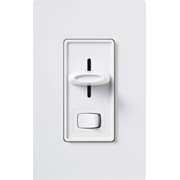
Dimmers
Dimming allows for change in the ambiance of a space by altering the light level. Using only the light level needed at a particular time saves energy, but the energy savings from dimming are relatively small compared with the possible energy savings from switching from incandescent bulbs to CFLs or LEDs. If lower light outputs are consistently desired, consider using lower wattage or fewer bulbs instead of a dimmer.
Wall-mounted dimmers are available in many styles such as toggle, rotary, linear slide, and touch. Toggle dimmers look like a toggle switch and provide full-range dimming control. Rotary dimmers use a knob to adjust light output: push the knob to turn on/off, or turn the knob to alter light output. Linear slide dimmers provide dimming using an up/down slide element to adjust the lighting, and some have programmable "preset" buttons. Touch dimmers provide dimming control using a touch-sensitive panel. Bi-level dimmers are combined with a sensor to dim bulbs to a preset level when no motion is detected in a space, and some have programmable "preset" buttons. Socket and cord dimmers are used for plug-in table or floor fixtures that are not manufactured with a dimming switch.
Dimming incandescent bulbs, including halogen, decreases the light output, decreases energy use, and extends the life of the bulb. Dimming fluorescent lamps decreases light output and energy use, but does not extend life. Dimming LEDs may extend life.
Cautions
- A qualified electrician should install hard-wired lighting controls.
- It is important to consider dimmer compatibility when installing these devices in the home. In general, CFLs can be dimmed only if they are labeled "dimmable" on the package. Linear fluorescent tubes require a special ballast and wiring to be dimmed. LEDs that are rated by the manufacturer to be "dimmable" will dim on most residential dimmers, but to ensure good dimming performance check on the LED bulb package and the dimmer package for compatible products. Incandescent bulbs, including halogen, are an inherently dimmable technology and will not say this on the package.
- Occasionally operate halogen bulbs at full output to retain the benefits of the halogen cycle.
- Low-voltage incandescent bulbs, such as some MR16s, require dimmers specific to this bulb type.
- Dimmers should incorporate electromagnetic interference (EMI) and radio frequency interference (RFI) filters to prevent causing static on radios or on audio equipment.
- Make sure dimmers click fully off; otherwise, the bulbs will draw current which wastes energy and may shorten bulb life.
